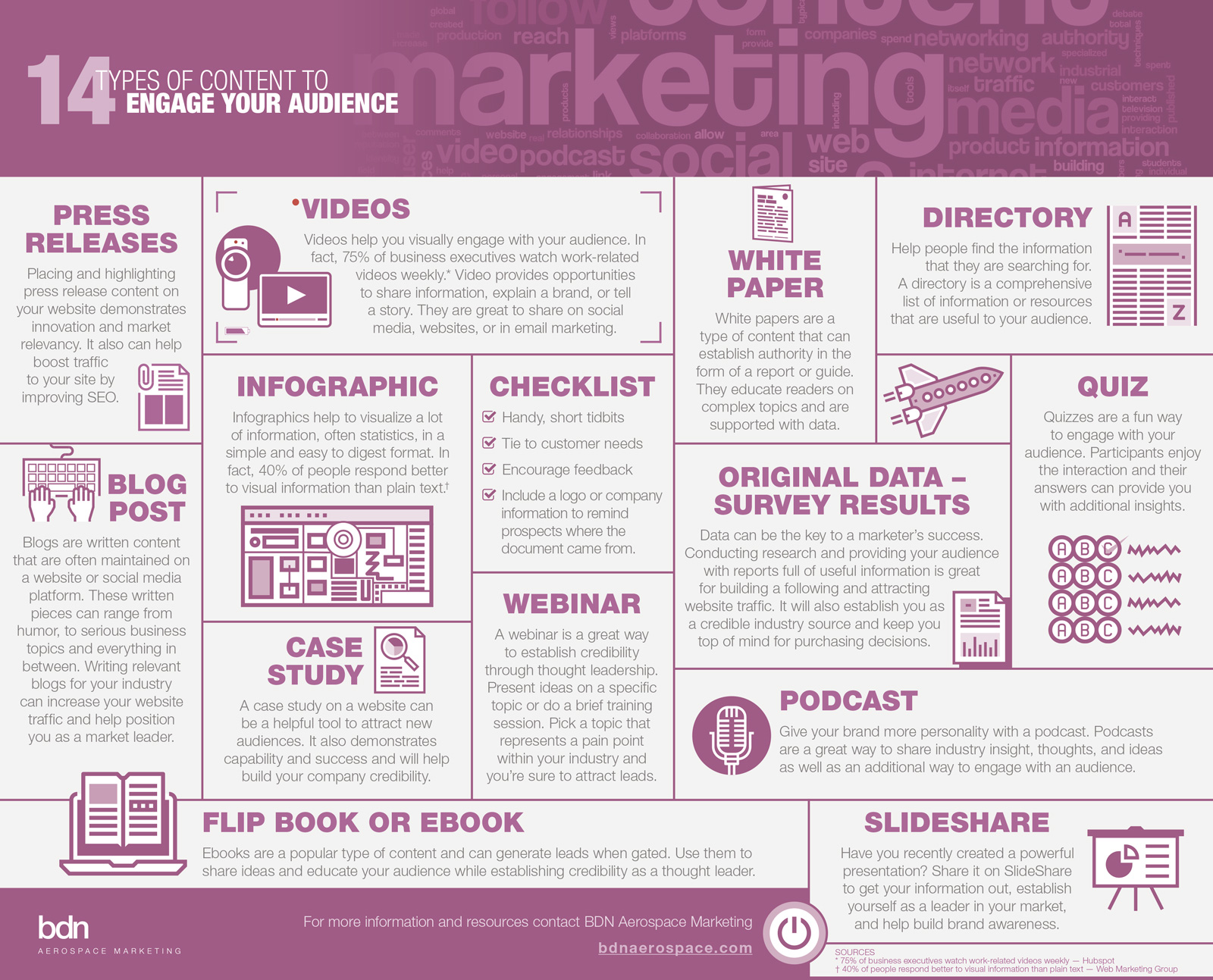Month: January 2016
Sales Enablement: Expert Q&A
 So far this month we’ve talked about inbound marketing, 14 types of content to engage audiences, and lead generation. Each of these activities is part of the lead nurturing process that moves prospects through the funnel toward the ultimate goal of becoming a closed sale.
So far this month we’ve talked about inbound marketing, 14 types of content to engage audiences, and lead generation. Each of these activities is part of the lead nurturing process that moves prospects through the funnel toward the ultimate goal of becoming a closed sale.
Of course, clients don’t always come to us with a request to enable sales — sometimes a discussion begins with ideas for possible solutions to a different perceived problem. But when we confer and dig deeper, the desire to increase sales and revenue is usually what is driving everything, and that makes sense. After all, the purpose of marketing is to enable sales.
In this installment of the Marketing Flight Manual, Lisa Sifuentes, BDN’s Vice President of Client Services and resident sales enablement expert, answers some commonly asked questions.
Why does BDN care about sales enablement? Is it a buzzword or here to stay?
We care about sales enablement because it aligns with our core beliefs that: the purpose of marketing is to enable sales; marketing can and should be accountable for results; and marketing efforts can and should be measured. It is not a buzzword or a flavor of the month — sales enablement is what modern marketers can and should be doing. More importantly, it’s what today’s clients need, want and expect — results, in the form of sales and revenue.
What is sales enablement? Can you give some examples?
Sales enablement is a proven business process that involves activities that sales and marketing teams perform to help sales operate more effectively. Aberdeen Research has shown that leading organizations applying sales enablement techniques are seeing results such as:
- 99% overall team attainment of sales quota
- 9% advantage in year-to-year revenue growth over average companies
- 4% year-over-year growth in average deal size
Just imagine delivering results like these in your organization. It would clearly position you as a business expert, enhancing your credibility and increasing your influence of the marketing function.
What are the challenges associated with sales enablement?
One common challenge is in overcoming the status quo and introducing new ideas and ways or working. Also, effective sales enablement depends on a closely aligned sales and marketing team. These two organizations can no longer act as adversaries but must come together behind a clear and common goal that neither can accomplish alone. Read more about breaking down the wall between sales and marketing at Media Bistro.
Finding the time and resources to measure and track results can also be challenging for aerospace, aviation and defense marketers, but measurement is essential to success. Learn more about measurement in Marketo’s Definitive Guide to Marketing Metrics and Analytics.
What marketing technique(s) might BDN use to help enable sales?
We’ve covered several techniques in this series, but specifically we employ email marketing, content, thought leadership and marketing automation.
Wrapping things up – Can you give our readers three tips to get started?
The most important thing is just getting started, and it’s OK to take baby steps and increase your capabilities for sales enablement over time. With that in mind, here are three things to start with today.
- Make sure your sales team can find and easily deploy content available to them. Simplify the delivery process and communicate.
- A Customer Relationship Management System – get one.
- Content calendar. Have sales and marketing brainstorm types of content that might be useful to your target audiences. You know more than you think and just need to put forward the effort to draft and distribute helpful information and resources.
P.S. Last week we promised more information about how to nurture and guide prospects through the funnel to a closed sale and satisfied customer. Silverpop has a comprehensive white paper, “From Cold to Hot: Lead-Nurturing Programs that Generate Sales” that covers this important topic very well.
Don’t forget: Digital marketing is key to most lead-generation efforts. Download this useful digital marketing guide to learn more.
4 Keys To Lead-Generation Success
Information from Forrester Research Inc. shows that B2B marketers still spend the lion’s share of their budgets on in-person trade shows and events, closely followed by digital advertising/marketing, with content marketing, websites, and digital marketing tied for third place, followed by a broad range of other expenditures.
Our experience in aviation, aerospace and defense marketing confirms the Forrester findings. We especially see that website updates and development has become a priority for many clients. In some cases, these marketers have realized that the time has come to modernize their current site for content, design and functionality. But, increasingly, the need to update a website is driven by a higher-level strategy to use the site as the hub of a larger marketing effort, often an inbound marketing program designed to generate leads from a pool of self-directed buyers who navigate the sales process without the help of a sales rep. In fact, Forrester reports that today’s B2B buyers are two-thirds to 90 percent of the way through their purchase journey before reaching out to the vendor they have found online.
If your marketing group wants to begin using inbound marketing techniques for lead-generation, start by evaluating these four areas:
- How will you get visitors to your website?
- How will you reward visitors who visit your site? What will you give them?
- How will you collect information from them?
- How will you use the information you collect?
How will you get people to your website?
The first step in converting a website visitor into a lead, is to attract and build web traffic. But how can you make sure the right people are finding and visiting your website?
- Organic SEO — Optimize your website to appear in top-ranking search positions by using targeted keywords and by frequently publishing content, including helpful blogs, that is relevant to your audience.
- Social media — Engage with a social media audience by posting content that is entertaining, educational, relevant, and timely. Observe patterns, note when your audience is the most active online, and post then. Posting articles and links back to your website will drive traffic.
- Eblast marketing — Sending out an email is a great way to increase website traffic. Eblasts can include a brief preview of blog posts (this week’s most popular blogs, recently published, etc.) or links to other tools on your website, webinars, and other events.
- Cross linking — Make sure that your business is listed in all relevant directories, and offer to guest blog on other websites. Reaching out will increase your reach and drive additional audience to your website.
For more information, refer to “What is Inbound Marketing?” the first blog in this Flight Manual series.
How will you reward the people who visit your website? What will you give them?
To generate leads, you need to collect contact information from the people who visit. But once a visitor is on your website, they are not just going to fill out a form for the sake of filing out a form. Make sure your website is full of useful tools, and valuable information or offerings that are so desirable visitors will be motivated to complete a form.
- Variety — Provide a range of content types (checklists, infographics, tool kits, white papers, educational seminars or webinars, etc.) and subject matter to attract the audience you want and to ensure that visitors find something that is a good fit for them.
To see a related infographic, click here.
How will you collect information from the visitors to your website?
Leverage technologies to gather the contact information you seek in the most efficient, effective ways possible.
- Forms — Forms are the most common way to collect information from website visitors. Make sure you aren’t asking for more information than you need, though, because lengthy forms may scare leads away.
- Subscriptions — Encourage people to subscribe to your newsletters or podcasts.
- Register for an event — Host local events (panel discussions, happy hour mixers) or virtual events (webinars or conferences) and encourage people to register ahead of time online.
- Download content — Consider gating some of your content (with a form) to gather additional information from website visitors.
SumoMe — Evaluate tools like SumoMe that make it easy to add forms to quick and easy sign ups on your website. Free and paid options are available, depending on your needs.
Landing pages — Research tools like Unbounce to create custom landing pages. For each campaign, there should be a specific landing page that drives the visitor to convert, instead of allowing them to get distracted on your website and venture away from completing a form.
How will you use the information you collect?
Once you have your leads, what happens next? Is there an immediate handoff to sales? Is marketing out of the picture?
This is where lead-nurturing techniques come into play, and where close alignment between marketing and sales is essential.
Next week’s blog will focus on setting expectations and how to nurture and guide prospects through the funnel to a closed sale and satisfied customer.
In the meantime, there are plenty of online resources where you can learn more about best practices in B2B lead generation. These include, but are not limited to, Pardot, Hubspot, and Marketo.
Don’t forget: Digital marketing is key to most lead-generation efforts. Download this useful digital marketing guide to learn more.
14 Types of Content To Engage Your Audience
[vc_row][vc_column][vc_column_text]Today’s consumers have learned how to shut out traditional marketing tactics. Television commercials can be fast forwarded and online banner ads no longer grab our immediate attention. Marketers need to adapt their strategies to re-engage and once again capture their customer’s attention.
Content marketing is an effective way to attract and retain customers by consistently creating, curating and providing relevant and valuable information. But what exactly is content?
Check out BDN’s newest infographic below, or download “14 Types of Content To Engage Your Audience” here.
Sources
“75% of business executives watch work-related videos weekly” – Hubspot
“40% of people respond better to visual information than plain text” – Web Marketing Group[/vc_column_text][/vc_column][/vc_row]
How to Make Inbound Marketing Work for Your Aviation Business
 Aerospace and aviation companies looking for every competitive advantage should be taking a closer look at inbound marketing. Inbound delivers a range of important benefits, including:
Aerospace and aviation companies looking for every competitive advantage should be taking a closer look at inbound marketing. Inbound delivers a range of important benefits, including:
- Reaching and engaging closely targeted prospects
- Generating quantifiable leads
- Elevating and building credibility for your brand
- Becoming a thought leader in your market
- Increasing your website traffic and search engine ranking (SEO)
What is Inbound Marketing?
Inbound marketing is a philosophy that challenges traditional, interruptive techniques for an all-new approach based on attraction. It’s designed to complement today’s B2B buying behavior, and it works.
It’s called inbound because it draws potential customers in to you, eliminating the need to reach out with a cold call or email. Just imagine – the customers come to you!
Inbound marketing works when you help your audience find you (via your website) and give them answers to burning questions, hard-to-find information they need or want, help with their most difficult challenges or even authentic inspiration or motivation. In a word, content. We’ll talk more about that in next week’s chapter.
As HubSpot, an inbound marketing authority says, “by publishing the right content in the right place at the right time, your marketing becomes relevant and helpful to your customers, not interruptive.”
The most important thing to remember is this — everyone is looking for help — but no one is looking to be sold.
Why Should You Care?
If you want a more relevant, efficient and effective marketing program, you should care about inbound marketing. Inbound generates more qualified and receptive leads, at less cost with a higher conversion rate, than traditional outbound marketing.
Traditional Marketing Examples
Depending on the plan and frequency, these items can add up fast, potentially totaling hundreds of thousands of dollars.
- Advertising
- Direct Mailers
- Purchasing Lists
Inbound Examples
Depending on your internal resources, many inbound tactics have little or no cost.
- Blogging
- Content
- Subscriber List
If you have something to say, or something to sell, inbound marketing creates an environment by which someone who needs your product can easily find you. And that’s something any marketer can get behind.
What Should I Do to Get Started?
Here are 7 phased steps to jump-start your effort.
Phase 1
- Create and maintain a modern, up-to-date website that is mobile- and search-engine friendly. This is the hub of your inbound program. Be sure to include an area for viewers to subscribe to your content.
- Hold a brainstorm meeting to gather content ideas. Ask yourself “what questions do customers or prospects most frequently ask? What are current hot topics or needs in the market?”
- Create a content and tactical monthly calendar – this should be the foundation for all your marketing-related activities.
- Create and distribute your content through channels like email, social media, website and blogging.
Phase 2
- You should see a spike in website traffic as a result of your content and promotion strategy. Begin converting traffic into leads by using landing pages, savvy calls to action and substantial content and offers.
- Use lead nurturing techniques to convert leads into sales, integrating with your Customer Relationship Management (CRM) software.
- Convert customers into brand ambassadors.
How Can it Work for Aviation, Aerospace and Defense Businesses?
BDN began using inbound techniques for our own business in July 2015, and the results have been more than encouraging. In fact, this blog is one important element of a multi-dimensional strategy that is delivering real results.
A wide variety of B2B businesses in an array of industries are making inbound work for them, and you can, too. Hubspot did a helpful piece about “16 Companies in Boring Industries Creating Remarkable Content,” and if boring industries can do it, imagine the potential for aerospace. Our work and products are exciting, but we default to presenting them in expected, non-interesting ways.
GE — well known within the aviation sector — is breaking away from the norm and is widely recognized for having a best-in-class inbound program that is refreshingly modern and unexpectedly unique and creative. Examples include Pinterest boards entitled “Mind=Blown” and “Badass Machines,” and a humorous take on the Ryan Gosling “Hey Girl” meme featuring Thomas Edison. Other examples include entertaining science-related YouTube videos and Txchnologist, a magazine designed to highlight “the great challenges of our era through industry, technology and ingenuity.”
In addition to BDN’s Inbound Marketing case study and Hubspot, here are some other relevant resources to expand your knowledge and understanding of inbound marketing:
- Learn how to cultivate subscribers and why they are better than leads here.
- Marketo is an alternative to Hubspot.
- Jay Baer is a renowned social media and content marketing consultant and his Convince and Convert blog is a great, worthwhile read.
Don’t forget: Digital marketing is key to most lead-generation efforts. Download this useful digital marketing guide to learn more.

